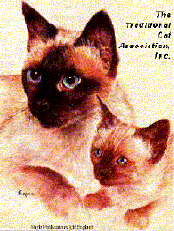
 The
Traditional Cat Association,
Inc.©1987®TM
Official Website
The
Traditional Cat Association,
Inc.©1987®TM
Official Website
Founded 1987, by Diana L.
Fineran
|
" Home of the Traditional Cat"© |
|
Our Motto: To Preserve,
Protect, Perpetuate, and Promote Traditional Cats.© |
|
|
||||
|
|
HISTORY OF THE THE TRADITIONAL ORIENTAL SHORTHAIR©®, THE TRADITIONAL ORIENTAL LONGHAIR©®, THE CLASSIC ORIENTAL SHORTHAIR©®, THE CLASSIC ORIENTAL LONGHAIR©® CAT
Breeders of the TRADITIONAL ORIENTAL SHORTHAIR©®, THE TRADITIONAL ORIENTAL
LONGHAIR©®, THE CLASSIC ORIENTAL SHORTHAIR©®, THE CLASSIC ORIENTAL
LONGHAIR©® GENERAL The desire to produce all the possibilities of color and pattern in a cat that has its foundation in the Siamese breed, caused the creation of the Oriental Shorthair and Oriental Longhair. In the past, blue-eyed, color pointed cats were owned by Royalty and were kept in the Royal Palace of Siam. The Siamese breed, however, is only one of several varieties native to the area. The Cat Book Poems, a manuscript written in Siam (now Thailand) some time between 1350 and 1767 A.D., describes and shows a variety of cats native to the area, including solid black, black and white bicolor, solid brown, blue/gray, and shaded silver, as well as cats bearing the point restricted color pattern. The cat’s portrayed in the book had bodies, legs, ears and heads, much like that of today’s Traditional Siamese and Classic Siamese and the related breeds. Some of the first cats imported to England from Thailand were solid or bi-colored. It wasn’t until the 1920’s, when the British, Siamese Cat Club issued a statement excluding all other colors, that the blue eyed, pointed cat became the Siamese norm in Britain. The concept of cats with the Siamese body style but with a wide range of colors and patterns had captured the interest and imagination of cat fanciers. It was only a matter of time before these cats entered the cat fancy, with a little help from breeders with a flair for exterior decorating. The Oriental of today is not a direct import from Thailand, but rather a Siamese hybrid developed in the 1950’s and 1960’s. The breeds’ creation was deliberate, purposeful and preconceived. Breeders wanted a cat that looked and acted like a Siamese but came in a wider range of colors. In the 1950’s British breeders crossed Siamese cats with domestic shorthairs and Russian Blues. In the late 1960’s American breeders, fascinated with the British Oriental, took up the torch and crossed Siamese, domestic shorthairs and Abyssinians to create a new look. Since them it has rapidly increased in popularity. In recent years the Oriental has been consistently ranked high among short haired breeds. Since the Siamese has the long haired Balinese associated with it, and the Colorpoint has the long haired Colorpoint Siamese (Javanese in some groups), it seemed only right that the Oriental Shorthair should have its own long haired variation. To that end, the Oriental Longhair became the newest addition to the long line of Siamese derived breeds. The breed is growing in popularity and appeals to the cat lover who wants the gorgeous body type and personality of the Siamese, the wash and wear hairdo of the Balinese and the myriad of colors of the Oriental Shorthair. The Oriental Longhair was developed in the late 1970’s by breeders who crossed the Oriental Shorthair with the Balinese. Their fur offers easier up keep than most long haired breeds, since it lacks the downy undercoat. The coat is exquisitely pettable. One owner said, “They’re wonderful, they’re marvelous, they’re gorgeous, they have superb dispositions, they’re very friendly and outgoing, and they love people. The Oriental breed can provide a cat for just about anyone. The body type of the Oriental is virtually the same as the Siamese. What sets the breed apart is the wide variety of colors and patterns. Un-like the Siamese that comes in only four colors and one pattern, the Oriental is available in a cornucopia of over 300 color and pattern combinations. Some colors are more common than others. For instance, solid black is the most common. Pure white, chestnut, blue, and black tabby are also popular. However, the breed offers just about every possible color and pattern. ORIENTAL PERSONALITY © Copyright: Heather E. Lorimer 2006 © The personality of the Oriental is as distinctive as the multi-colored exterior. They are natural entertainers, full of enthusiasm, energy, and the belief that the world should revolve around them. Haughty and royal one minute, they are animated and inquisitive the next. They are highly curious, and will go to great lengths to be involved in your activities. When you are busy, they will find ways to interject themselves on your activities, such a little nudge while your eat or help typing your shoes. They will enjoy the warmth of your lap, provide a wonderful purr and nuzzle your face then you need it the most. They are snugglers, wanting to be on your bed and most of all at your side. They are wonderful sleeping companions, sharing the bed, pillows and covers. Orientals’ feelings are easily hurt if you ignore them, but given their full share of affection, Oriental’s will repay you with a life time of love, affection, and intelligent conversation. They usually bond with one person and become extremely devoted and dependent upon their chosen human. They will do just about anything to please you. Expect them to be at your side, in your lap, and at the door to interrogate you about where you’ve been. Curiosity and intelligence combine in the Oriental, providing the cat a means of finding anything and everything. They have been known to open drawers to find their favorite toy. They remain playful, spirited and loyal well beyond their youth. The breed’s vocal tone is generally softer and milder than that of the Siamese, but the range, frequency and inflection vary from cat to cat. Like their Siamese relatives, they are never at a loss for words on any subject. ORIENTAL HEALTH © Copyright: Diana Fineran and Ave’ Rustad, March 17, 2006 © The Oriental breed is in general a healthy breed. Those that are of the Extreme Wedge variety (not supported by TCA, INC.) can suffer from the same defects as the Extreme Wedge Siamese. Protrusion of the cranial sternum is a common, though not serious, defect seen in some Extreme Wedge Siamese and related breeds. Endocardial fibroelastosis is a more serious anomaly that can be found in some Extreme Siamese lines. All cats deserve to be bred for health, longevity, a lack of lethal genes, and a lack of deformity. Therefore, TCA, INC. is promoting these Breed Standards as a healthful direction for the Orientals.
|
|
The Traditional Cat Association, Inc.©1987®TM ALL RIGHTS RESERVED © by John & Diana Fineran - Aug 1999- 2025 No portion of this website or any information contained within it may be copied, or in any way distributed, without the expressed written permission of John or Diana Fineran - No exceptions. |